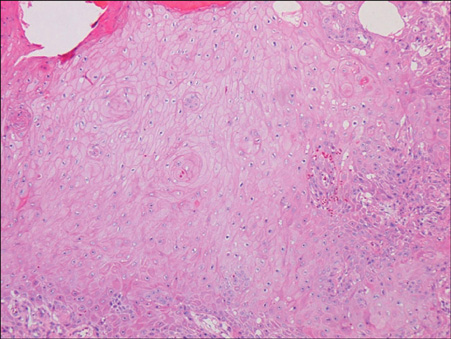Ann Dermatol.
2011 Dec;23(Suppl 3):S346-S349. 10.5021/ad.2011.23.S3.S346.
Surgical Treatment for 11 Cases of Penile Verrucous Carcinoma
- Affiliations
-
- 1Department of Urology, Huashan Hospital, Fudan University, Shanghai, China. dingqiangd@hotmail.com
- KMID: 2171869
- DOI: http://doi.org/10.5021/ad.2011.23.S3.S346
Abstract
- Penile verrucous carcinoma is a rare, well-differentiated and low-grade tumor. The surgeons are deficiently aware about the biological behavior and the clinicopathological characteristic of this disease, which raises difficulties during the treatment. In our present study, the clinical and pathological data of 11 patients with penile verrucous carcinoma, aged between 49 to 85 years was retrospectively analyzed. The tumors exhibited exophytic, papillary, caulifower-like or verrucose lesions of great dimensions measuring between 2 to 10 cm on the penises. The tumors were located at glans in 6 cases, invaded the coronoid sulcus in 4 cases and invaded the shaft of the penis in 1 case. Eight cases underwent partial penectomy, while the other 3 were treated with local excision. The diagnosis of penile verrucous carcinoma was confirmed by histopathologic examination of the specimens with the negative surgical margins in all the cases. Within the period of 12 to 60 months of follow-up, all the patients were disease-free with no case of recurrence and metastasis. The novel knowledge and experience of the treatment of penile verrucous carcinoma will be a useful clinical guide for surgeons in the future.
Keyword
MeSH Terms
Figure
Reference
-
1. Stankiewicz E, Kudahetti SC, Prowse DM, Ktori E, Cuzick J, Ambroisine L, et al. HPV infection and immunochemical detection of cell-cycle markers in verrucous carcinoma of the penis. Mod Pathol. 2009. 22:1160–1168.
Article2. Noel JC, Vandenbossche M, Peny MO, Sassine A, de Dobbeleer G, Schulman CC, et al. Verrucous carcinoma of the penis: importance of human papillomavirus typing for diagnosis and therapeutic decision. Eur Urol. 1992. 22:83–85.
Article3. Ackerman LV. Verrucous carcinoma of the oral cavity. Surgery. 1948. 23:670–678.4. Schwartz RA. Verrucous carcinoma of the skin and mucosa. J Am Acad Dermatol. 1995. 32:1–21.
Article5. Rinker MH, Fenske NA, Scalf LA, Glass LF. Histologic variants of squamous cell carcinoma of the skin. Cancer Control. 2001. 8:354–363.
Article6. Antony FC, Ardern-Jones M, Evans AV, Rosenbaum T, Russell-Jones R. Giant condyloma of Buschke-Loewenstein in association with erythroderma. Clin Exp Dermatol. 2003. 28:46–49.
Article7. Gross G, Pfister H. Role of human papillomavirus in penile cancer, penile intraepithelial squamous cell neoplasias and in genital warts. Med Microbiol Immunol. 2004. 193:35–44.
Article8. Hatzichristou DG, Apostolidis A, Tzortzis V, Hatzimouratidis K, Ioannides E, Yannakoyorgos K. Glansectomy: an alternative surgical treatment for Buschke-Löwenstein tumors of the penis. Urology. 2001. 57:966–969.
Article9. Sheen MC, Sheu HM, Huang CH, Wang YW, Chai CY, Wu CF. Penile verrucous carcinoma successfully treated by intraaortic infusion with methotrexate. Urology. 2003. 61:1216–1220.
Article10. Micali G, Nasca MR, Innocenzi D, Schwartz RA. Penile cancer. J Am Acad Dermatol. 2006. 54:369–391.
Article11. Kanik AB, Lee J, Wax F, Bhawan J. Penile verrucous carcinoma in a 37-year-old circumcised man. J Am Acad Dermatol. 1997. 37:329–331.
Article12. Majewski S, Jablonska S. Human papillomavirus-associated tumors of the skin and mucosa. J Am Acad Dermatol. 1997. 36:659–685.
Article13. Pilotti S, Donghi R, D'Amato L, Giarola M, Longoni A, Della Torre G, et al. HPV detection and p53 alteration in squamous cell verrucous malignancies of the lower genital tract. Diagn Mol Pathol. 1993. 2:248–256.
Article14. Eble JN, Sauter G, Epstein JI, Sesterhcnn IA, editors. World Health Organization classification of tumours: pathology and genetics of tumours of the urinary system and male genital organs. 2004. Lyon: IARC Press.15. Wein AJ, Kavoussi LR, Novick AC, Partin AW, Peters CA. Campbell-Walsh urology. 2007. 9th ed. Philadelphia: Saunders Elsevier.
- Full Text Links
- Actions
-
Cited
- CITED
-
- Close
- Share
- Similar articles
-
- A case of Verrucous Carcinoma Arising on the Glans Penis with Insertion of Penile Prosthesis
- A Case of Verrucous Carcinoma Arising in Penile Lichen Sclerosus et Atrophicus
- Synchronous Verrucous Carcinoma and Squamous Cell Carcinoma of Penis by Different Human Papillomavirus Infections
- A Case of Verrucous Carcinoma Improved by 5% Imiquimod Cream
- Two Cases of Verrucous Carcinoma of the Larynx



